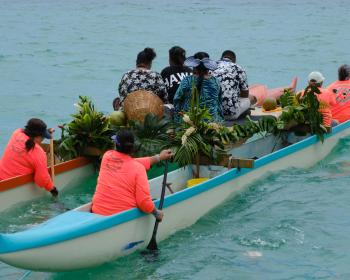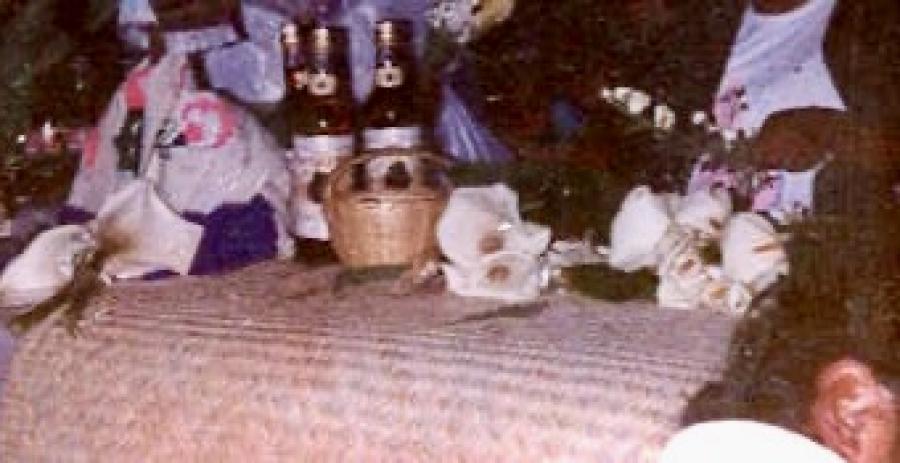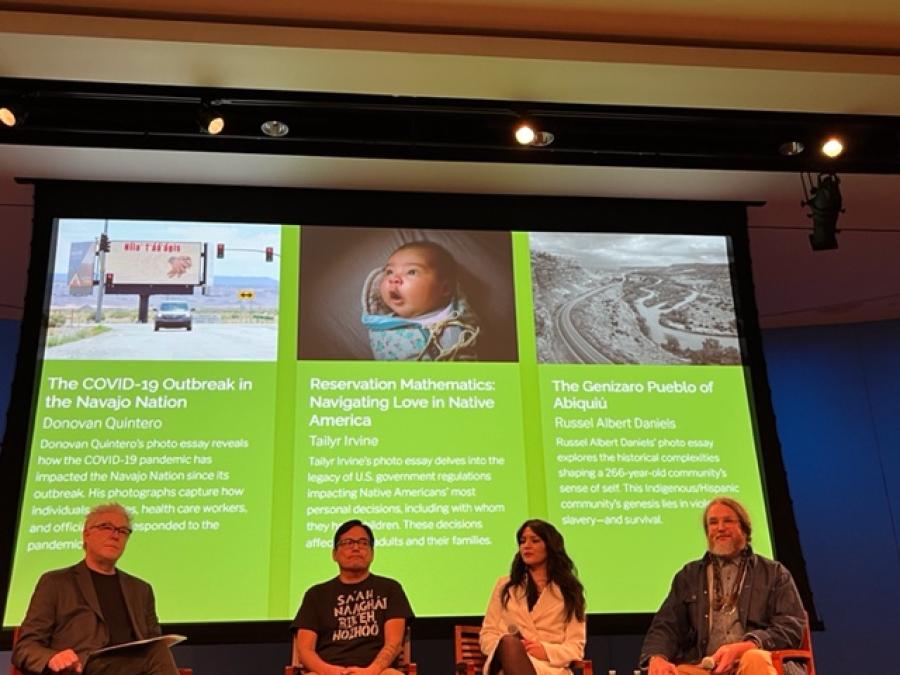Cultural Survival is concerned with the struggles of indigenous peoples. This article considers the relation between these cultures and museums, where objects are "cultural momentos," "works of primitive art," or "artifacts of ethnographic research." Other articles presented here (such as that by Tobias Schneebaum) discuss still other kinds of museums and exhibit styles.
To go beyond the "Please Do Not Touch" signs in museum exhibits we must examine how the study of material culture and cultural survival are linked. Such issues as exhibit styles and the general view of the relationship between indigenous peoples and museums must be raised.
The wide variety of museums and their differing roles and resulting styles presents an initial problem. For years arguments have raged about whether the material culture of non-western peoples should be viewed in primarily a scientific or an aesthetic light. These views reflect curators' attitudes towards non-western people.
Harry Shapiro, of the American Museum of Natural History, states,
The primitive artist works in a tradition and does not use his skills or art as personal vehicle for the expression of his own emotions and reactions. He is subordinate to his culture and is never in revolt from it. Thus the isolation of primitive art from its source and inspiration can only fail to present the whole of it...primitive art belongs with its culture and should be exhibited in reference to it. Such a task belongs in the anthropological field. The entrance of the art museum into this area constitutes an overlapping of function that is difficult to justify…
Shapiro 1958:49-50
In contrast, Douglas Newton, curator of the Rockefeller wing of the Metropolitan Museum of Art, has a different kind of respect for "primitive" artists and puts them on equal footing with western artists. "When anthropologists criticize art museums they are exhibiting unconscious ethnocentrism. They see a real separation between western culture and other cultures. I like to see it as a cultural continuum."
There are problems with either extreme. Providing a sufficient cultural context in a museum cabinet is difficult, if not impossible. Many exhibits clutter objects with excessive and outdated text. Yet the "high art" approach, isolating objects from culture, obscures the realities of non-western people. Neither style provides a historical context, necessary for the discussion of cultural survival issues.
Exhaustive collecting of "cultural artifacts" has existed for at least 400 years. Yet few have linked the growth of museums with the increasingly threatened existence of those cultures on display, or questioned either the ethics of collecting contemporary cultural artifacts or its consequences on small societies. Karl Hutterer, of the Museum of Anthropology, University of Michigan, is an exception:
The act of collecting ethnographic specimens must be seen as an act of taking possession, both physically and symbolically, of some of the essence of individuals as well as whole societies and cultures. For the Third World, this aspect of private and museclogical collecting is just another element of the larger colonial context.
Hutterer 1980:7
Who in the United States, for example, would not be upset if the Soviet Union preserved the Declaration of Independence as an artifact of a dying culture?
The effects of collecting on indigenous people can be devastating. The removal of sacred pieces not only causes a shortage of necessary ceremonial objects, but belittles indigenous religion. The lack of respect in handling or removing sacred objects may result in spiritual crises which aid the efforts of missionaries. The change in native art styles, resulting from commissions from those with their own ideas about "primitive art," the encouragement to mimic western styles and the wishes of the tourist trade can destroy the local belief systems that were the basis of the art. Also, the trading with collectors is often the first intrusion of the market economy into some communities.
When the overall relationship is viewed from both sides, from the exhibit hall to the long house, from the curator to the native artist, it can be seen that the study of material culture should not be separated from the issues of cultural survival, both because of the long term effects of collecting and the fact that the continued creation of indigenous art relies, obviously, on the continued existence of indigenous culture. Yet a false dichotomy between science and object, artifact and human, museum and native struggle still prevails. Examples of this dichotomy appeared in the midst of the Wampum controversy in 1970. The Six Nations of the Iroquois had been trying for 90 years to regain possession of many sacred wampum beads that were stored in the New York State Museum in Albany. A letter from six curators from museums around the country (e.g. the Smithsonian, to the Chicago Field Museum, to the Peabody Museum of Salem, Mass.) was sent to then Governor Rockefeller:
As scholars whose researches depend on the great ethnographic collections of now largely vanished peoples of the world we urge the preservations of such momentos of culture in museums. We deplore the principle of returning such treasures to the acculturated descendants of their original owners lest a precedent be established that would require logically returning Ibo carvings to Nigeria, Asmat art to New Guinea, and the works of Florentine painters to Italy.
Sturtevant, et. al. 1970:17
There is, unfortunately, little legal structure at this time to serve as guidelines for relations between museums and contemporary indigenous peoples. International agreements and national legislation that protect "cultural property" deal mainly with archeological artifacts, and any articles retrieved or recovered often wind up not with the people they came from but in national museums. The restitution of cultural objects remains a largely unexplored territory. In the U.S. there are a few court cases pending, such as the issue of reburial of native bones in California, though these have resulted in little but hurt feelings on both sides.
A recent set of events in upstate New York illustrate an encouraging alternative. Richard Hill, a Tuscarora of the Beaver Clan of the Six Nations, became a full-time staff member of the Buffalo and Erie County Historical Society in 1973. His people had long felt that many exhibits were both culturally inaccurate and religiously offensive. Rather than close the door to Native American concerns, the historical society worked to resolve the issues. The museum staff and a six-member Iroquois advisory committee negotiated the return of sacred objects and planned new exhibits. Skeletal remains were returned for burial. Medicine masks were taken off exhibit and are lent to religious leaders for ceremonial purposes. Several thousand wampum beads were returned. Following this, Native American students made clothes and other objects for a new exhibit in the museum.,/P>
Stereotypes of both museums and Indians have dissolved as the Hodenosaunee's cultural values have renewed through common efforts...the historical society's objectives are no longer centered solely on the possession of cultural treasures, but on proper utilization of religious and sacred articles...(these) are significant accomplishments, but they are only a beginning. If other museums and communities follow, perhaps peace can be restored.
Hill 1977:43-44
Others programs and experiments do exist. The Museum of The American Indian of the Heye Foundation in New York, with several Native Americans on their board, has contemporary native artists exhibit their work, and, like the Smithsonian, has internships for native researchers. The Rockefeller wing of The Metropolitan Museum now has an "information room" with several video machines and films documenting the Asmat and peoples of the Northwest Coast, among others. Museums can be a forum for the discussion of significant issues that confront contemporary indigenous peoples. But this works best when museums use the resources of the people concerned.
Increasingly, indigenous peoples all over the world have called on museums to help publicize their plight. They believe that museums have a responsibility to indigenous peoples, and that both groups stand to gain in the fulfillment of that responsibility.
Article copyright Cultural Survival, Inc.



